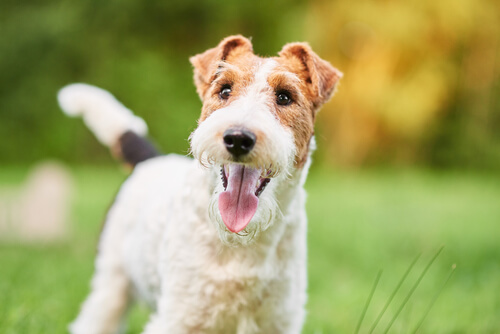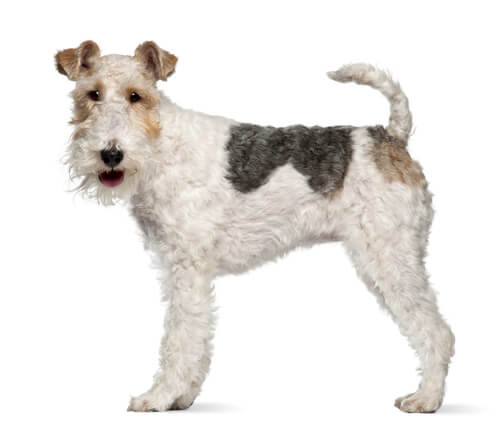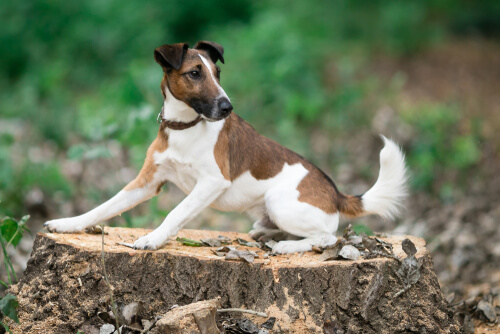
| Kingdom | Animalia |
| Phylum | Chordata |
| Class | Mammalia |
| Order | Carnivora |
| Family | Canidae |
| Genus | Canis |
| Species | Canis lupus |
| Subspecies | Canis lupus familiaris |
| Height | 13-14 in (36-39 cm) |
| Weight | 14-17 lbs (6-8 kg) |
| Lifespan | 12-15 years |
| Social Structure | Domesticated |
| Natural Habitat | Domesticated |
| Average Litter Size | 3-6 puppies |
| Main Food Item | Dog Food |
| Potential Predators | Few predators |
The Basics
The Fox Terrier refers to two different medium-small sized breeds of domestic dogs, the Smooth Fox Terrier and the Wire Fox Terrier. They are descendant from earlier terriers, which were used for hunting game birds. Both breeds originated in the 1800s and are related to other modern white terrier breeds such as Jack Russel Terrier and Miniature Fox Terrier. Their small size allows them to chase quarry – groups of game birds – into a burrow or den. Fox Terriers in particular were also used to flush other animals such as fox from their dens for hunters. They are now common show dogs and pets as well.

Wire Fox Terrier and Smooth Fox Terrier are very similar in appearance. The primary distinction between the two is their coat. Despite similar coloration and marking, Wires have longer, wiry fur while the Smooths have a shorter, smooth coat. Both variants are mostly white with some brown, dark grey and nearly black markings on their bodies and faces. Fox Terriers are typically about 14 inches (39 cm) tall at the shoulders or withers and weigh 14-17 pounds (6-8 kg). Their heads are long and wedge-shaped with small, partially folded, v-shaped ears. Females typically give birth to litters of about 3-6 puppies. Puppies’ coats may be shorter than adults, but is still relatively coarse.

Little but Loyal
Fox Terriers are common as pets. They are intelligent and have plenty of energy. Anyone looking to take them on as pets should be prepared to provide plenty of exercise and attention in order to avoid them misbehaving. They are very loyal to their families and notoriously good with children as they love to play. However, Fox Terriers can be aggressive and unpredictable towards other dogs. Therefore, it is important to socialize them at a young age in order to get more accustomed to the presence of other pets. With a firm and consistent approach, they are very trainable and learn tricks easily.
Although they are small, their high energy levels make them poorly suited for apartment living. Fox Terriers should only be considered by potential owners who will provide it with a large, enclosed and secure outdoor area for it to use.
Fun Facts about Fox Terrier!
Fox Terriers are still occasionally used for hunting but have been popular as pets since the 1930s when a film series known as The Thin Man featured a Wire Fox Terrier named Asta. Prior to that, a Smooth Fox Terrier had appeared in the RCA records logo with a keen expression and its head cocked, apparently listening to an early record player.
Big in the States
Despite being from England originally, the Fox Terrier has become a star in America in particular. It has found success in conformation shows worldwide but is particularly popular and successful in America. In fact, the Smooth Fox Terrier has claimed four Best in Show titles while the Wire Fox Terrier has claimed the title fourteen times. In contrast, it has only won Best in Show at Crufts – a prestigious dog show in the United Kingdom – a total of three times. Smooth Fox Terriers are listed as a Vulnerable Native Breed in the UK, indicating that there are fewer than 300 new registrations of the breed with the Kennel Club each year.
Fox Terriers were officially recognized by England’s Kennel club in 1875. In fact, it was the first in the terrier group to receive this distinction. However, since then its popularity has diminished significantly. Luckily for the breed, they have been a success in America since the first recorded import occurred in 1879.
Form Meets Function
Fox Terriers were developed strategically and for a purpose. Because they were used to flush foxes and birds from their dens, they were bred to be increasingly white in color. The more white a dog had on its coat the easier it was for hunters to distinguish it from the foxes they were targeting with their guns.

A Pure Bred ‘Mutt’
Despite the Fox Terrier pedigree existing from 1870 onwards, their earlier breeding history is foggy. In fact, it is believed that various disparate species were all involved in the creation and stabilization of the breed. These potential bloodlines include Beagles, Old English Bulldog, Pointer, Dalmatian, and English Toy Terrier, among others.
In addition, Fox Terriers themselves have been used in the development of other now distinct breeds such as the Toy Fox Terrier, a cross of Smooths with Chihuahuas, and other breeds. The popular Jack Russel Terrier too is a descendant of these Terriers. It was developed for working by Reverend John Russel in the 1800s as a smaller variety of the Fox Terriers.

Clearly, the early crossbreeding makes it difficult to determine exact lineages. In fact, it wasn’t until 1985 that the American Kennel Club formally recognized the two breeds as distinct. This explains why they share a common name despite their somewhat distinctive appearances.
